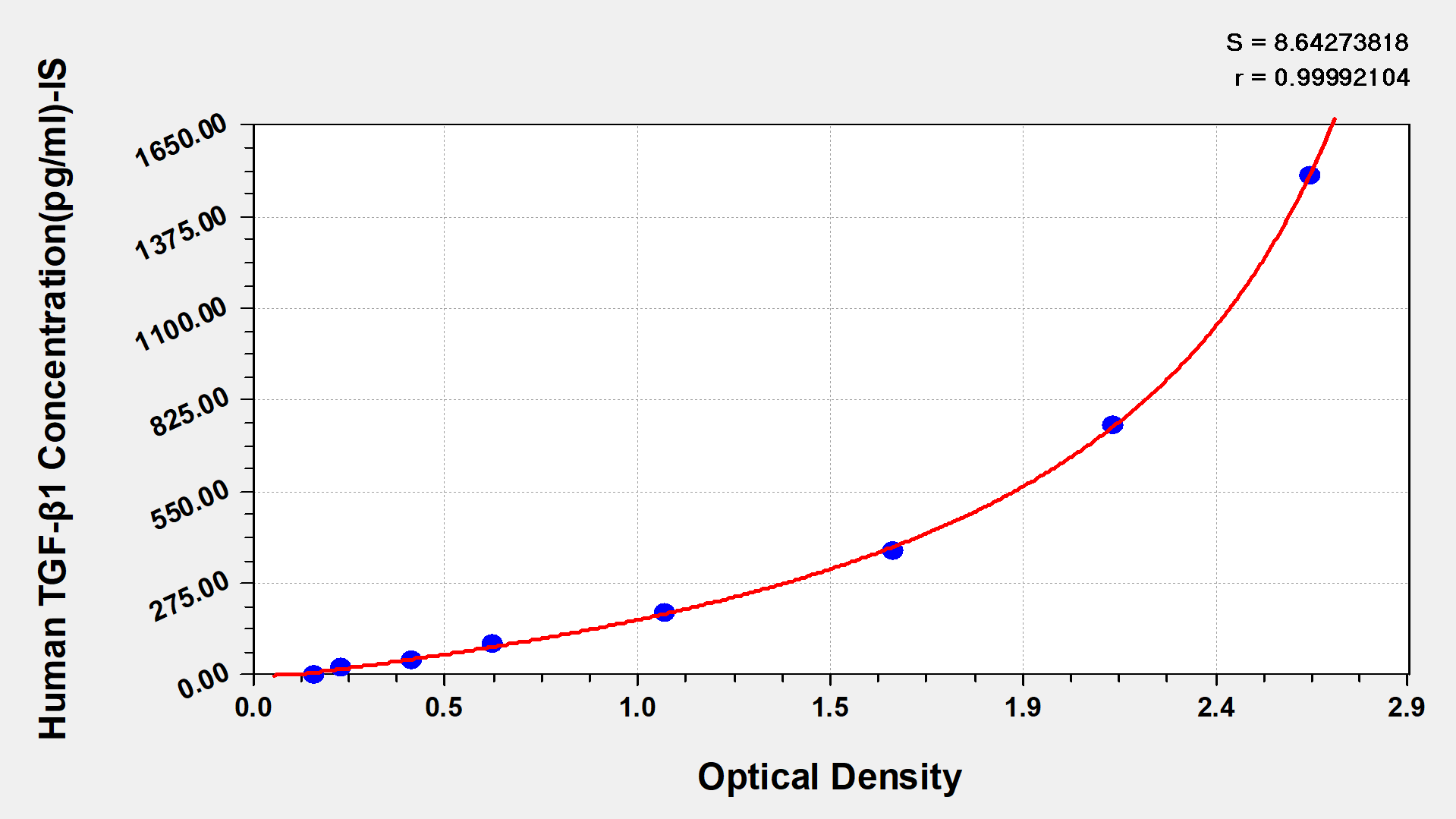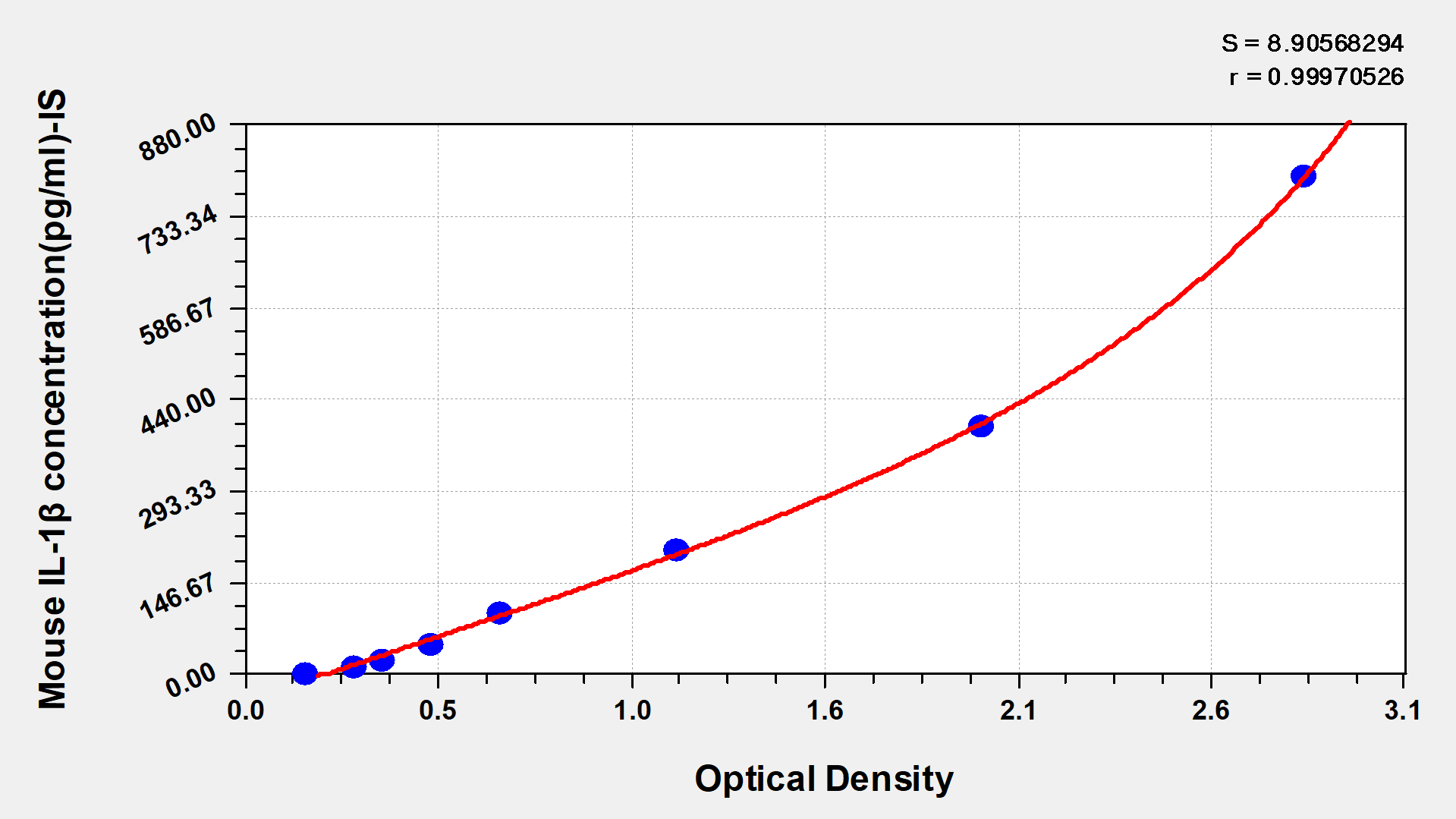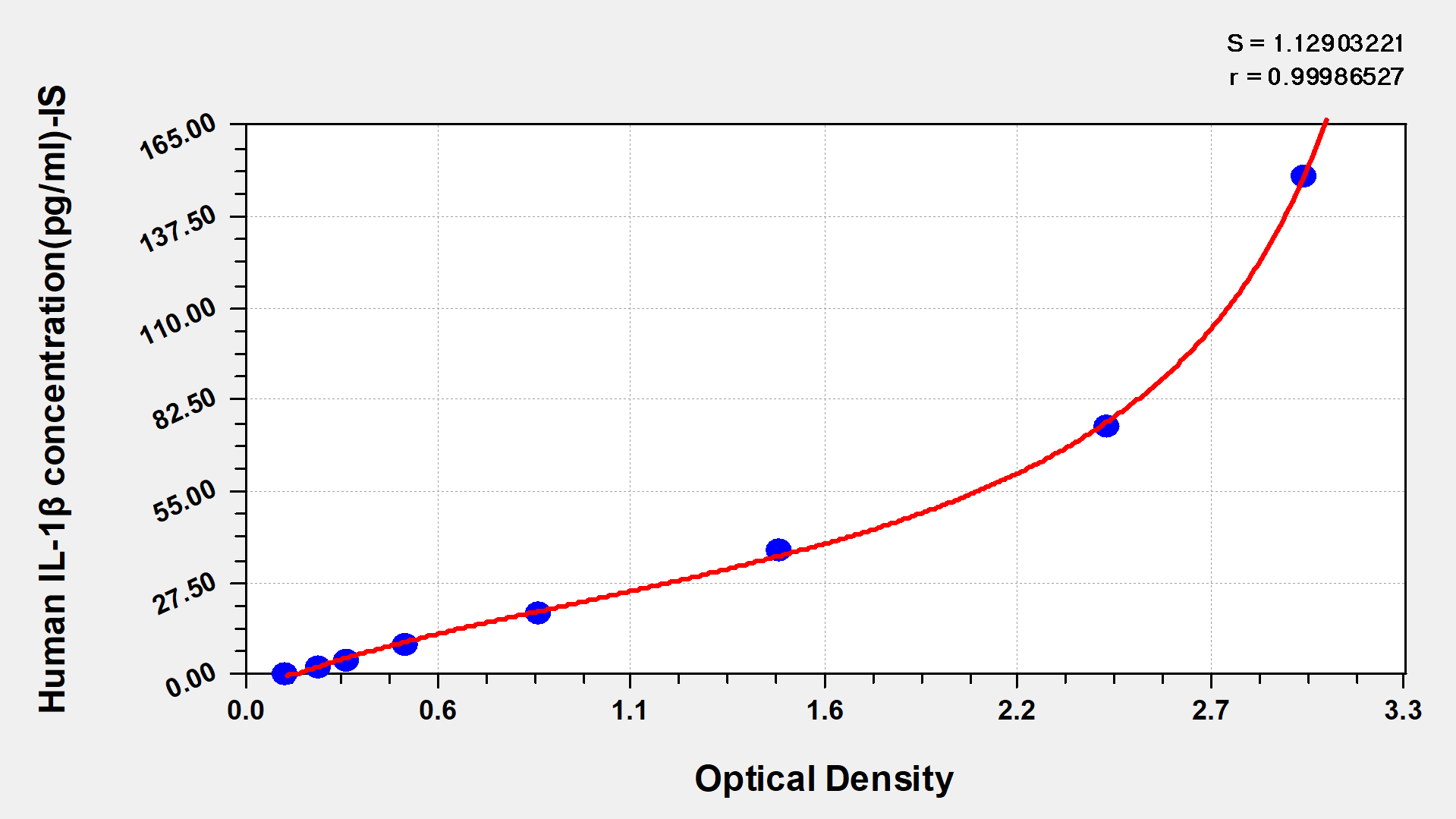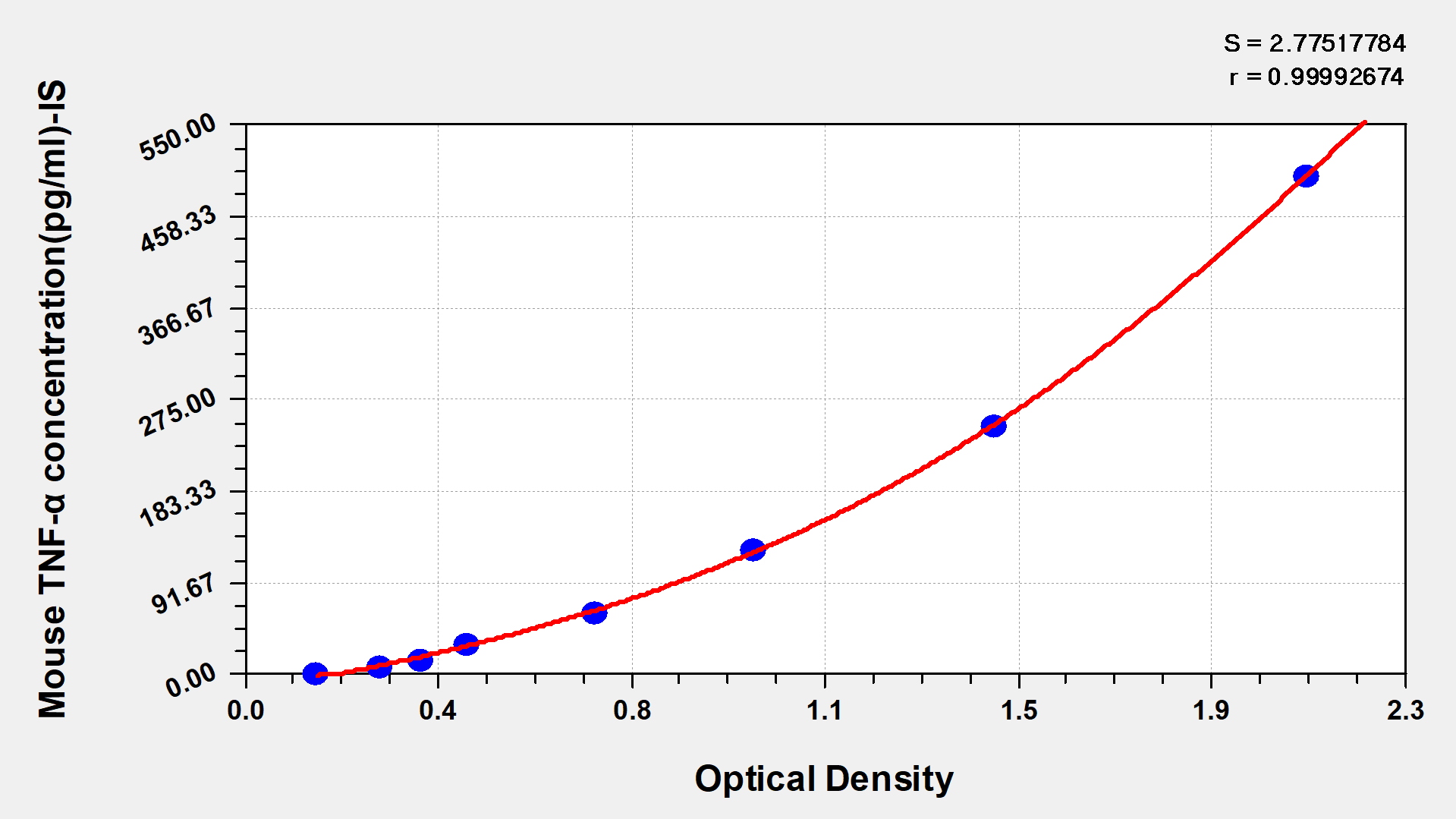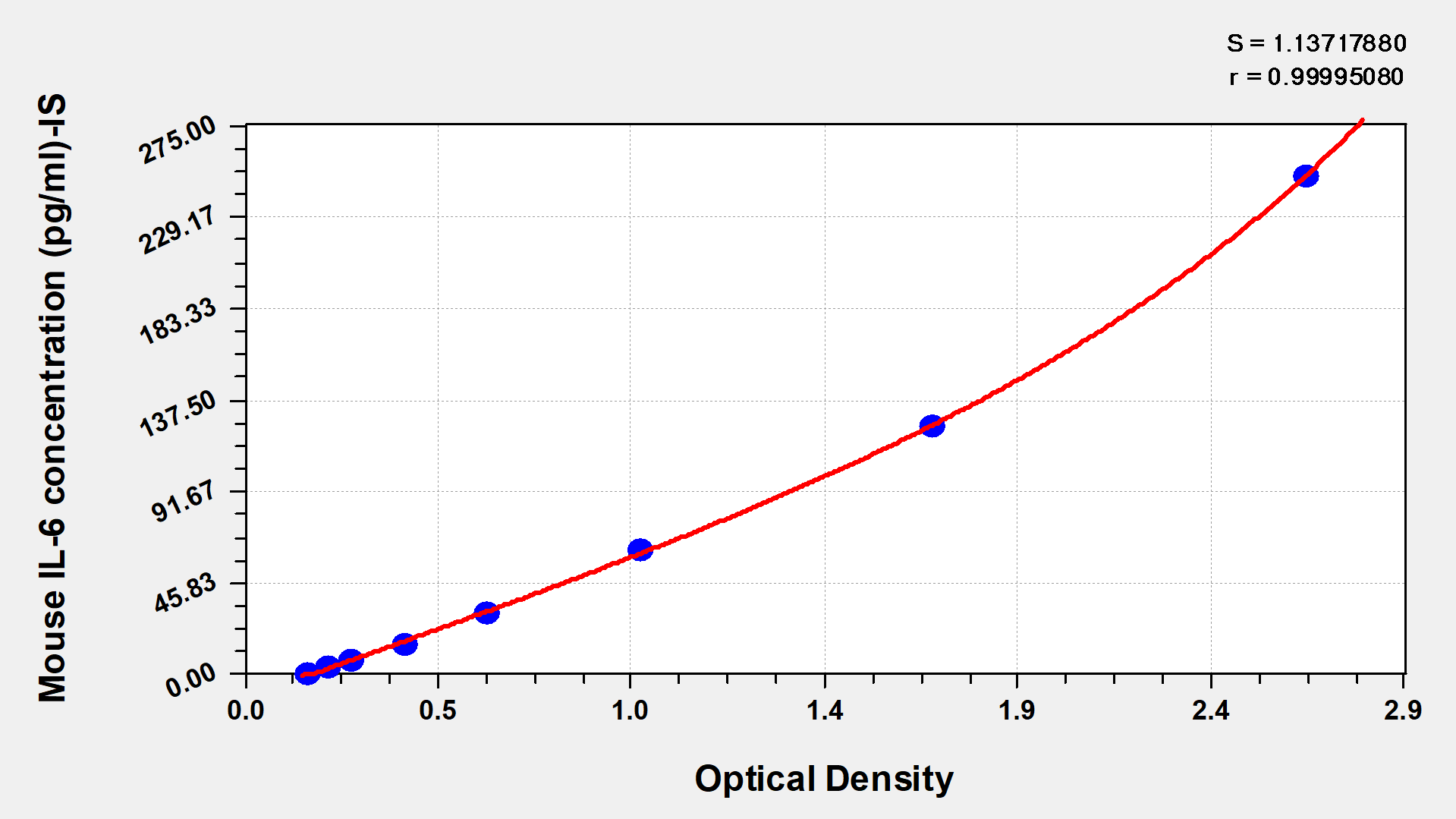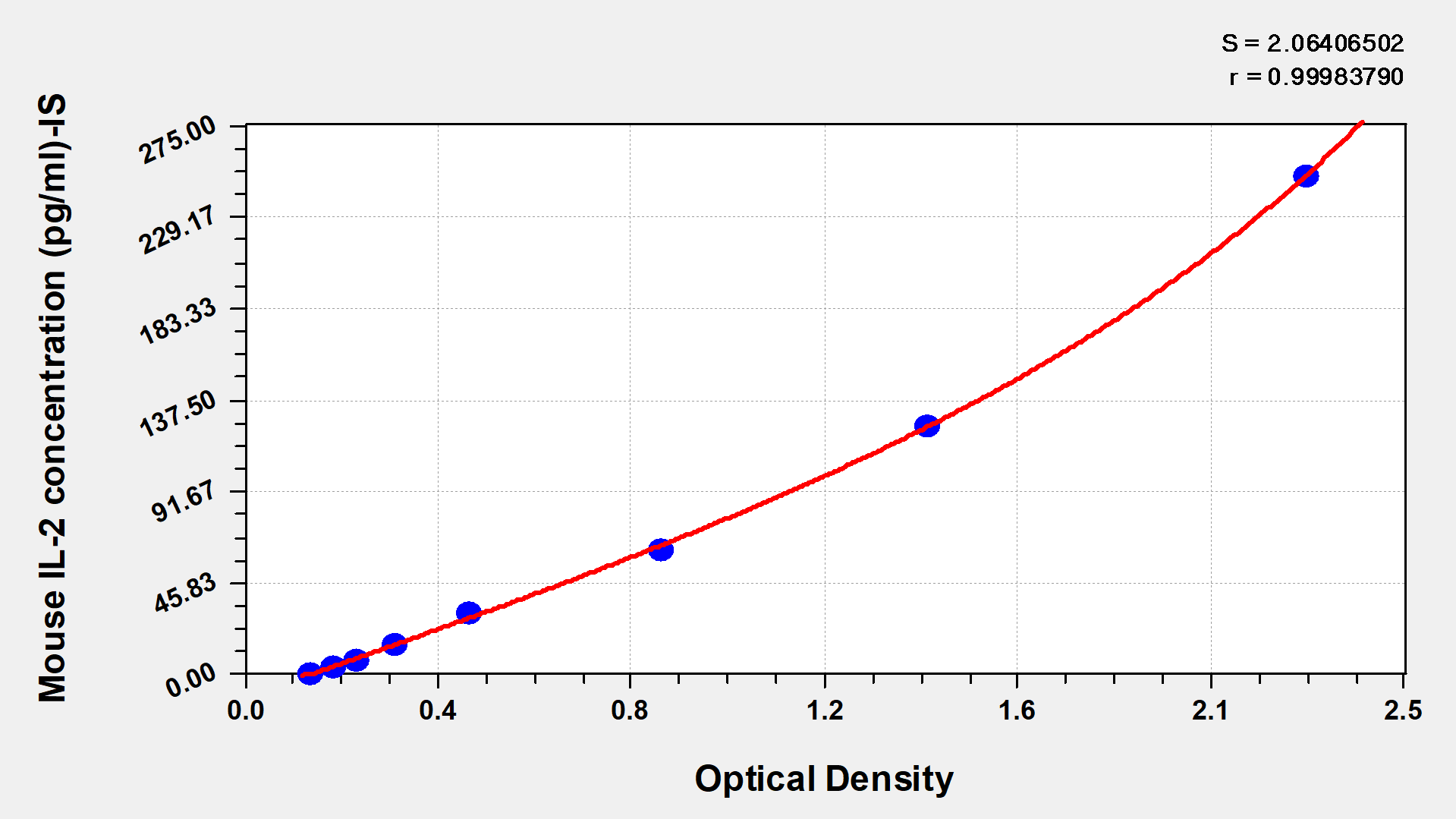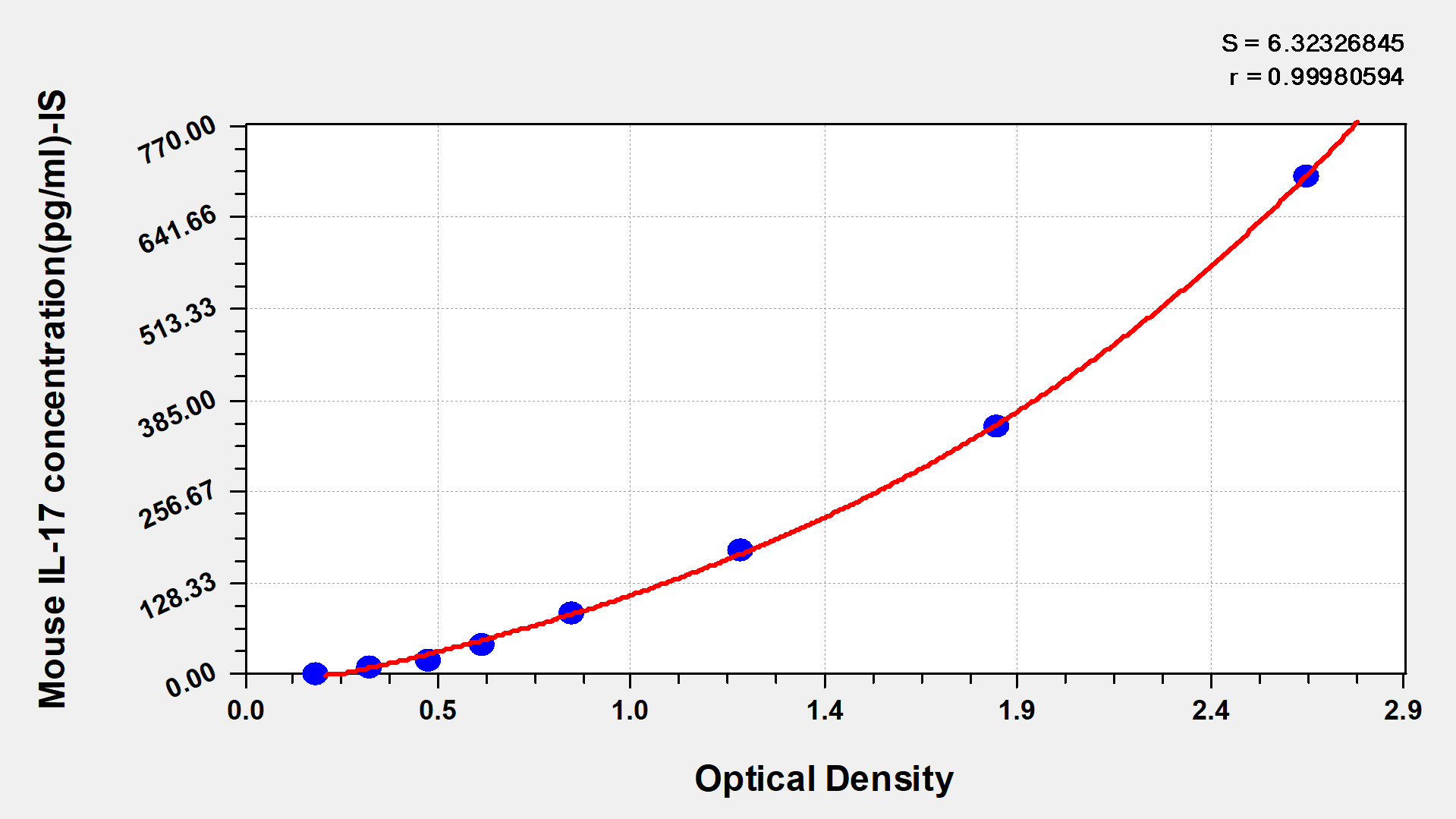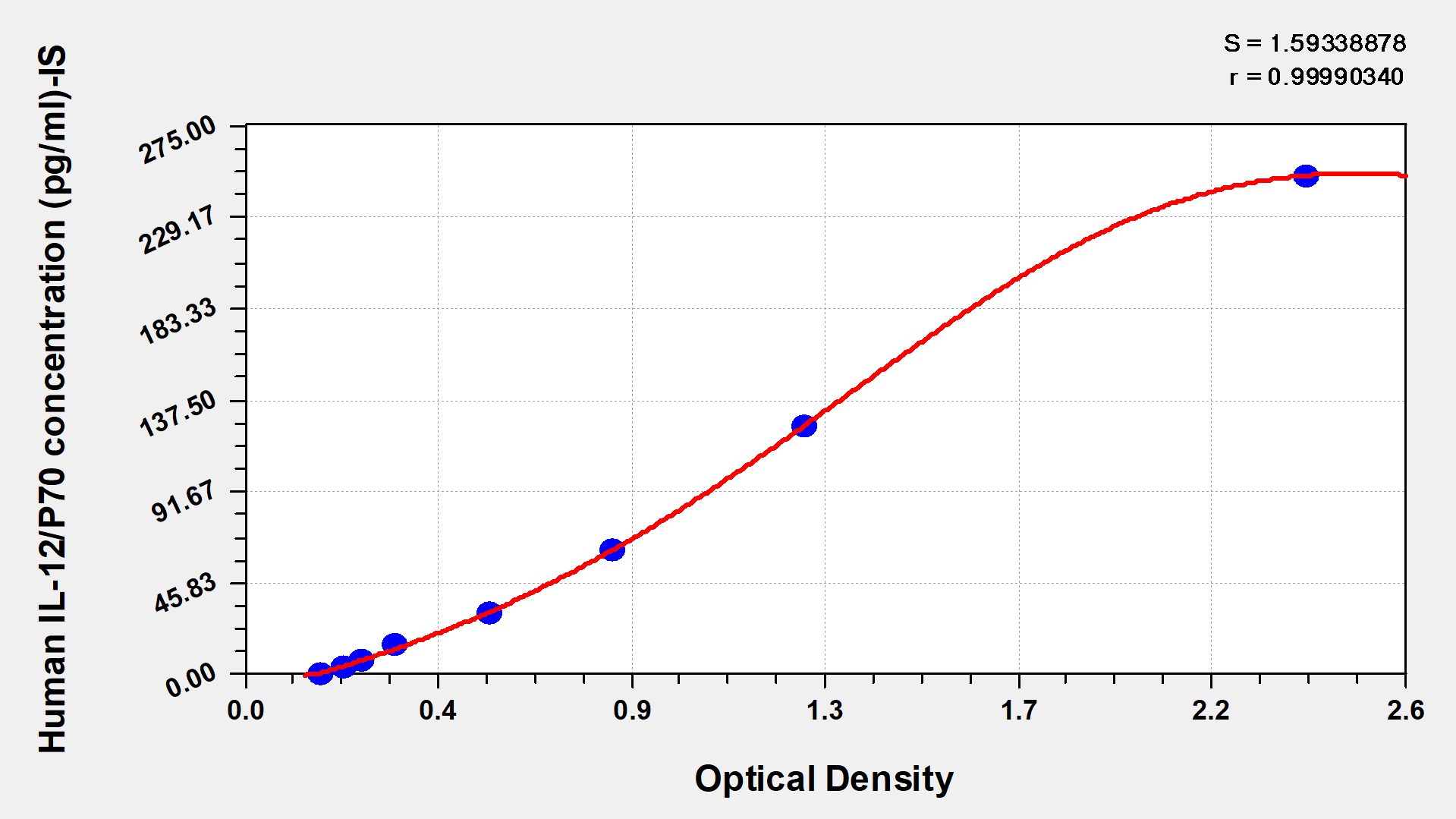Human Pulmonary surfactant-associated protein A,SP-A ELISA Kit

產品詳情
-
產品描述:
人肺表面活性物質相關蛋白A(SP-A)酶聯免疫試劑盒(CSB-E08683h)為雙抗夾心法ELISA試劑盒,定量檢測血清、血漿、組織培養上清液、尿液樣本中的SFTPA1含量。人肺表面活性物質相關蛋白A(SP-A)是肺泡表面活性物質的主要蛋白成分,具有降低肺泡表面張力、調節表面活性磷脂合成與分泌等作用。研究顯示,SP-A在肺損傷和慢性阻塞性肺疾病中發揮重要作用,其基因多態性與疾病易感性相關。試劑盒檢測范圍為15.6 pg/mL-1000pg/mL,該產品適用于基礎科研中探索SP - A在呼吸系統疾病(如肺炎、急性呼吸窘迫綜合征、肺纖維化)中的生物學功能,或用于藥物開發、毒理學研究中評估肺組織損傷及修復的生物標志物變化。其廣泛的樣本兼容性為細胞模型、動物實驗及臨床前研究提供靈活選擇,尤其適合需要高靈敏度定量分析的實驗場景。本品僅用于科研,不用于臨床診斷,產品具體參數及操作步驟詳見產品說明書。
-
別名:
SFTPA1; COLEC4; PSAP; SFTP1; SFTPA; SFTPA1B; Pulmonary surfactant-associated protein A1; PSP-A; PSPA; SP-A; SP-A1; 35 kDa pulmonary surfactant-associated protein; Alveolar proteinosis protein; Collectin-4
-
縮寫:
SFTPA1
-
Uniprot No.:
-
種屬:
Homo sapiens (Human)
-
樣本類型:
serum, plasma, cell culture supernates, urine
-
檢測范圍:
15.6 pg/mL-1000pg/mL
-
靈敏度:
3.9 pg/mL
-
反應時間:
1-5h
-
樣本體積:
50-100ul
-
檢測波長:
450 nm
-
研究領域:
Signal Transduction
-
測定原理:
quantitative
-
測定方法:
Sandwich
-
精密度:
| Intra-assay Precision (Precision within an assay): CV%<8% |
|
|
|
| Three samples of known concentration were tested twenty times on one plate to assess. |
|
| Inter-assay Precision (Precision between assays): CV%<10% |
|
|
|
| Three samples of known concentration were tested in twenty assays to assess. |
|
|
| |
|
|
|
|
|
|
-
線性度:
| To assess the linearity of the assay, samples were spiked with high concentrations of human SP-A in various matrices and diluted with the Sample Diluent to produce samples with values within the dynamic range of the assay. |
| |
Sample |
Serum(n=4) |
|
| 1:100 |
Average % |
86 |
|
| Range % |
80-92 |
|
| 1:200 |
Average % |
97 |
|
| Range % |
91-105 |
|
| 1:400 |
Average % |
99 |
|
| Range % |
92-110 |
|
| 1:800 |
Average % |
93 |
|
| Range % |
86-98 |
|
-
回收率:
| The recovery of human SP-A spiked to levels throughout the range of the assay in various matrices was evaluated. Samples were diluted prior to assay as directed in the Sample Preparation section. |
| Sample Type |
Average % Recovery |
Range |
|
| Serum (n=5) |
93 |
89-98 |
|
| EDTA plasma (n=4) |
97 |
90-100 |
|
| |
|
|
|
|
|
|
| |
|
|
|
|
|
|
-
標準曲線:
| These standard curves are provided for demonstration only. A standard curve should be generated for each set of samples assayed. |
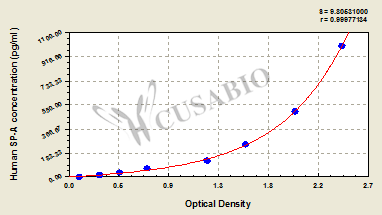
| pg/ml |
OD1 |
OD2 |
Average |
Corrected |
|
| 1000 |
2.420 |
2.418 |
2.419 |
2.318 |
|
| 500 |
2.008 |
1.999 |
2.004 |
1.903 |
|
| 250 |
1.582 |
1.555 |
1.569 |
1.468 |
|
| 125 |
1.248 |
1.211 |
1.230 |
1.129 |
|
| 62.5 |
0.709 |
0.689 |
0.699 |
0.598 |
|
| 31.25 |
0.472 |
0.436 |
0.454 |
0.353 |
|
| 15.6 |
0.290 |
0.269 |
0.280 |
0.179 |
|
| 0 |
0.104 |
0.098 |
0.101 |
|
|
|
-
本試劑盒所含材料:
- A micro ELISA plate ---The 96-well plate has been pre-coated with an anti-human SP-A antibody. This dismountable microplate can be divided into 12 x 8 strip plates.
- Two vials lyophilized standard ---Dilute a bottle of the standard at dilution series, read the OD values, and then draw a standard curve.
- One vial Biotin-labeled SP-A antibody (100 x concentrate) (120 μl/bottle) ---Act as the detection antibody.
- One vial HRP-avidin (100 x concentrate) (120 μl/bottle) ---Bind to the detection antibody and react with the TMB substrate to make the solution chromogenic.
- One vial Biotin-antibody Diluent (15 ml/bottle) ---Dilute the Biotin-antibody.
- One vial HRP-avidin Diluent (15 ml/bottle) ---Dilute the HRP-avidin solution.
- One vial Sample Diluent (50 ml/bottle)---Dilute the sample to an appropriate concentration.
- One vial Wash Buffer (25 x concentrate) (20 ml/bottle) ---Wash away unbound or free substances.
- One vial TMB Substrate (10 ml/bottle) ---Act as the chromogenic agent. TMB interacts with HRP, eliciting the solution turns blue.
- One vial Stop Solution (10 ml/bottle) ---Stop the color reaction. The solution color immediately turns from blue to yellow.
- Four Adhesive Strips (For 96 wells) --- Cover the microplate when incubation.
- An instruction manual
顯示更多
收起更多
-
本試劑盒不含材料:
- A microplate reader capable of measuring absorbance at 450 nm, with the correction wavelength set at 540 nm or 570 nm.
- An incubator can provide stable incubation conditions up to 37°C±5°C.
- Centrifuge
- Vortex
- Squirt bottle, manifold dispenser, or automated microplate washer
- Absorbent paper for blotting the microtiter plate
- 50-300ul multi-channel micropipette
- Pipette tips
- Single-channel micropipette with different ranges
- 100ml and 500ml graduated cylinders
- Deionized or distilled water
- Timer
- Test tubes for dilution
顯示更多
收起更多
-
數據處理:
-
貨期:
3-5 working days
引用文獻
-
The value of surfactant protein a in evaluating the severity and prognosis in community-acquired pneumonia patients
YP Deng, J Sun, QY He, Y Liu, L Fu, H Zhao,BMC Pulmonary Medicine,2024
-
Evaluating the diagnostic and therapeutic significance of KL-6 in patients with interstitial lung diseases
T Wang,/,2024
-
Blood Levels of Indicators of Lower Respiratory Tract Damage in Chronic Bronchitis in Patients with Abdominal Obesity
EV Kashtanova,Diagnostics,2022
-
Surfactant proteins of the human larynx
Sheats M.et al, Annals of Anatomy-Anatomischer Anzeiger,2016
靶點詳情
-
功能:
In presence of calcium ions, it binds to surfactant phospholipids and contributes to lower the surface tension at the air-liquid interface in the alveoli of the mammalian lung and is essential for normal respiration. Enhances the expression of MYO18A/SP-R210 on alveolar macrophages.; (Microbial infection) Recognition of M.tuberculosis by dendritic cells may occur partially via this molecule. Can recognize, bind, and opsonize pathogens to enhance their elimination by alveolar macrophages.
-
基因功能參考文獻:
- This study is suggestive that the PCR (polymerase chain reaction) for the detection of coa, mecA, and spa gene is a fast, accurate, and valuable diagnostic tool. PMID: 30074012
- TGF beta markedly decreased expression of SP-A, SP-B, SP-C, fatty acid synthase, and the phospholipid transporter ABCA3. However, TGF beta increased protein levels of SP-D with little change in mRNA levels. PMID: 29621540
- this study shows that concentrations of SP-A are associated with polarization of macrophages in pleural effusions of non-small cell lung cancer PMID: 29111316
- the SPA and SPD levels in EBC were correlated with lung function, which contributed to COPD diagnosis. PMID: 28791362
- Data (including data from studies using transgenic/knockout mice) suggest that surfactant protein A1 (SPA1) interferes with EGF binding to EGFR in pulmonary alveoli cell lines; SPA1 directly binds extracellular domain of EGFR; binding of SPA1 to EGFR appears to be different from binding of SPD to EGFR; binding of SPA1 to EGFR does not suppress EGF-induced phosphorylation of EGFR or cell proliferation. PMID: 28972165
- This review intends to provide a current overview of the genetics, structure and extra-pulmonary functions of the surfactant collectin proteins. PMID: 28351530
- The SFTPA1 haplotype comprising rs17881720-A and rs17879335-G was a resistance factor while the haplotype comprising rs1914663-T and rs1059225-G was found to be a susceptibility factor to tuberculosis in Han Chinese population. PMID: 27012150
- SP-A transiently enhances the basal protein expression of CHC and alpha-adaptin. PMID: 26771574
- the presence of SP-A1 allows pulmonary surfactant to adopt a particularly favorable structure with optimal biophysical properties PMID: 27508436
- SP-A1 6A4 and SP-A2 1A5 genetic variants may influence the susceptibility to respiratory distress syndrome in late-preterm infants, independently of the effect of other perinatal factors. PMID: 27835691
- Direct interaction between SP-A or SAP01 and human BD-3 seemed to be responsible for the inhibitory effects on chemotaxis of mast cells. PMID: 28188794
- SP-A (+186A/G) and SP-B (1580C/T) polymorphisms are strongly associated with the risk of respiratory distress syndrome (RDS) in preterm infants. Notably, reduced serum SP-A levels were correlated with a high risk of RDS and may serve as novel biomarkers for RDS detection and monitoring. PMID: 28011976
- Surfactant protein A levels differed among idiopathic pulmonary fibrosis, pulmonary sarcoidosis and chronic pulmonary obstructive disease. PMID: 27758987
- Differences were found regarding SPA and pro-SPB expression in the vast majority of subjects: in some lungs, SPA was more expressed whereas in others pro-SPB showed an higher degree of immunoreactivity. The expression of both surfactant proteins was not strictly correlated with gestational age. PMID: 27734990
- Study identifies SFTPA1 as a gene involved in familial idiopathic interstitial pneumonia and shows that altered SP-A1 expression is associated with a large spectrum of phenotypic pulmonary manifestations ranging from severe respiratory insufficiency occurring early in life to lung fibrosis and cancer in adult patients. PMID: 26792177
- These results suggested that the measurement of SPA levels in the exhaled breath condensate may serve as a method for monitoring airway obstruction in patients with chronic obstructive pulmonary disease. PMID: 26707652
- Human and murine data together indicate that SP-A, SP-D and MBL are synthesized in early gestational tissues, and may contribute to regulation of immune response at the feto-maternal interface during pregnancy. PMID: 26603976
- SP-A in exhaled particles from small airways may represent a promising non-invasive biomarker of disease in chronic obstructive pulmonary disease patients. PMID: 26656890
- In this study, the loci and haplotypes associated with pulmonary tuberculosis (PTB)were found mostly to be located in the SFTPA2 gene, suggesting that the effects of the SFTPA2 gene on PTB are stronger than those of SFTPA1. PMID: 24984162
- Data suggest that that surfactant protein A(SP-A) levels may be important to maintain surfactant function in the presence of high cholesterol within surfactant. PMID: 25522687
- SP-A modulates lung immune system in the area of non-infectious lung diseases such as acute and chronic pulmonary fibrosis and lung cancer. PMID: 24705741
- 12 of which predicted to bind SP-A 3'UTRs. PMID: 25058539
- This study shows that changes occur in the alveolar macrophage proteome in response to a single in vivo treatment with exogenous SP-A1 and/or SP-A2. PMID: 24954098
- SP-A1 transcripts, which in turn negatively affect SP-A1 translation, possibly affecting SP-A1/SP-A2 ratio, with potential for clinical implication. PMID: 25326576
- In this review, we highlight the associations of eosinophilic lung diseases with SP-A and SP-D levels and functions. PMID: 24960334
- sequence variability at the 3'UTR of SFTPA1 and SFTPA2 gene variants differentially affects miRNA regulation of gene expression. PMID: 24793167
- Results show that cloned surfactant-associated protein A (SPA) gene promoter had specific transcriptional activity in SPA high expression cells. PMID: 24939295
- The result suggested that polymorphism of aa62 (CCA/CCG, rs1136451) of SP-A may be associated with the susceptibility to COPD in Xinjiang Uighurs. PMID: 22528218
- The current meta-analysis indicates that common polymorphisms in the SP-A gene may contribute to increasing susceptibility to COPD, especially among Asian populations. PMID: 24093802
- SP-A gene polymorphism is associated with kidney graft rejection. PMID: 24007361
- SP-A inhibited lung cancer progression by recruiting and activating natural killer cells via controlling the polarization of tumor-associated macrophages. PMID: 23499372
- The obtained results suggested that in vitro approach can be used to study pulmonary toxicity as long as the applied in vitro model mimics closely the complexity of in vivo situation. PMID: 22769972
- Cat S may participate in the pathophysiology of cystic fibrosis by weakening the antibacterial activity of SP-A. PMID: 23707200
- The aim of this report is to describe the genetic complexity of the SFTPA1 and SFTPA2 genes, as well as to review regulatory mechanisms that control SP-A expression in humans and other animal species.[review] PMID: 23069847
- elevated expression in nasal mucosa in chronic rhinosinusitis with polyps PMID: 23406594
- Surfactant Protein-A, like other host defense molecules in the reproductive tract, appears to be regulated by gonadal hormones. PMID: 22672628
- Surfactant protein A associated with respiratory distress syndrome in Korean preterm infants: evidence of ethnic difference. PMID: 23038062
- Lipoteichoic acid can increase SP-A synthesis in human alveolar type II epithelial cells through sequentially activating the MEK1-ERK1/2-NF-kappaB-dependent pathway PMID: 23031213
- Gln238Lys missense variant of exon 6 in the SFTPA1 may have potential susceptibility in the development of IPF, which was shown in patients with sporadic IPF with a statistically higher frequency. PMID: 22884059
- Surfactant protein-A suppresses eosinophil-mediated killing of Mycoplasma pneumoniae in allergic lungs PMID: 22384248
- review focuses on published association studies of surfactant proteins A and D genetic polymorphisms with respiratory, and non-respiratory diseases in adults, children, and newborns [review] PMID: 22201752
- SP-A protects lung epithelium from tissue injury caused by BD3 PMID: 22418431
- Surfactant protein A is defective in abrogating inflammation in asthma. PMID: 21784968
- genetic variants of the surfactant protein A1 confer a protective phenotype against severe acute respiratory syncytial infection PMID: 21601013
- Both nasal polyps and nasal mucosa expressed SP-A mRNA and protein, but the expression was stronger in nasal polyps. PMID: 20873544
- The expression of SP-A in allergic rhinitis and nasal polyps was dramatically higher than that in controls. PMID: 19894557
- findings suggest that Suv39H1 and Suv39H2 are key hypoxia-induced methyltransferases; their decline in fetal lung during late gestation is critical for epigenetic changes resulting in the developmental induction of SP-A PMID: 21402781
- Paucity of immunohistochemical SP-A expression in alveolar epithelial cells in diseased areas may predict a worse prognosis for patients with idiopathic interstitial pneumonias. PMID: 21435274
- High SPA-1 is associated with invasion and metastasis of prostate cancer. PMID: 21251160
- SP-A likely plays a critical role in regulating prostaglandin production within the uterus, culminating at term in decidual activation and the onset of labor. PMID: 21270323
顯示更多
收起更多
-
相關疾病:
Pulmonary fibrosis, idiopathic (IPF); Respiratory distress syndrome in premature infants (RDS)
-
亞細胞定位:
Secreted, extracellular space, extracellular matrix. Secreted, extracellular space, surface film.
-
蛋白家族:
SFTPA family
-
數據庫鏈接:
Most popular with customers




